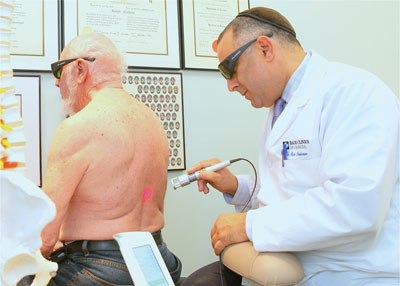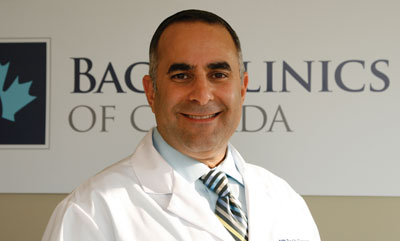
Over the past 20 years, technology has had a profound impact on the chiropractic profession. Among emerging technologies, therapeutic lasers are increasingly taking a more prominent position in treatment of chronic back and neck pain, lower back pain, sports injuries, and musculoskeletal conditions.
Over the past 20 years, technology has had a profound impact on the chiropractic profession. Among emerging technologies, therapeutic lasers are increasingly taking a more prominent position in treatment of chronic back and neck pain, lower back pain, sports injuries, and musculoskeletal conditions. Therapeutic lasers have had a dramatic impact on chiropractors’ ability to target and accelerate healing of injured soft tissue, resulting in noteworthy outcomes. They have a place in just about every back pain clinic. In fact, chiropractors are also seeing greater numbers of informed patients who are actively seeking laser therapy treatment for their pain.
 |
|
| Dr. Nusbaum performing laser therapy with a Class IV laser on Dr. Keith Quirk, MD. Advertisement
|
Class IV Advantages
With so many different lasers available, it can be confusing to figure out which one is right for your chiropractic clinic. But the therapeutic features and benefits of Class IV lasers are so significant that a growing number of doctors are considering including them in their arsenal of therapeutic treatment tools.
Compared to Class IIIa and Class IIIb therapy lasers, Class IV therapy lasers deliver more energy per unit of time, and therefore can deliver therapeutic dosages of laser light to a larger volume of tissue in a shorter period of time. Class IV lasers are most successful in treating chronic and deeper-seated soft-tissue problems. Class IV lasers also successfully enable regeneration and help to fight infection.
Deeper healing and pain relief is best achieved using Class IV lasers.
Clinical Success
The FDA in the United States approved three main indications for use of high-powered therapeutic lasers:
- mediation of chemical inflammation;
- an improvement in healing (the disc is largely avascular and slow to heal); and
- an analgesic effect.1
Recently Health Canada has approved a Class IV Laser in Canada.
The Class IV laser successfully treats a spectrum of conditions. The most common applications in the chiropractic clinic include myofascial pain syndromes and arthritic joints. It is effective in treating both soft-tissue injuries and chronic debilitating conditions. Of importance, and as mentioned above, deep-seated stubborn soft tissue that is hard to treat with many common modalities can be successfully healed using a powerful, deep-reaching Class IV laser.
Patients are responding to Class IV laser treatments with fantastic results.The stimulating healing effects of the laser are felt almost immediately. Results are cumulative. Because the Class IV laser delivers more power and greater depth of penetration, each treatment session is shorter and fewer treatments may be required, overall, when compared to lower-powered therapy lasers.
Doctors who are already using the Class IV laser in their clinics see that patient compliance and satisfaction is high. As well, the laser can smoothly integrate with other treatment modalities for potentially much greater interactive effect.
Technical profile of laser therapy
Power – Class IV lasers include all those lasers above 0.5 watts. Class IIIa lasers are continuous wave, intermediate lasers. These have a power output of 1-5 milliwatts. Class IIIb lasers may deliver continuous or pulsed wave. These have a power output up to 500 milliwatts, or 0.5 watts.
The Class IV laser can deliver a therapeutic dose of laser light faster than a Class III laser. To illustrate this, consider the following: the current accepted dosage for superficial pain is 2-4 Joules per centimetre; and for deep-lying pain 4-10 Joules per centimetre. If the condition being treated is deep-lying lumbar pain, the area being treated could be 100-400 centimetres.2 This equates to a total treatment dosage of 400-4,000 Joules. A Class IIIb laser with a 0.5-watt output would take anywhere from 13-133 minutes to administer this dosage. A Class IV therapy laser would deliver the same dosage in less than 10 minutes.
Higher wattage has been shown to reach a deeper target. This is because a sufficient number of photons produces the desired primary effects of photobiomodulation. For example, two watts would be used for lateral epicondylitis, five watts for cervical pain, or seven watts for lumbar pain.3 It’s important to understand which dose is the most effective for the condition being treated. But what is preferable is having a therapeutic laser in your hand that is equipped with customization features to make your treatments optimally efficient and safe.
By implementing proper use and safety precautions, the Class IV laser can be used safely and effectively, mitigating such risks as injury to the eyes. Training is readily available for you and your staff; in fact, it’s required. There is every reason for Class IV laser treatments to be delivered without side-effect or harm.
Depth of Penetration – Therapeutic lasers deliver photons (packets of light). These photons travel into and through soft tissue. When laser photons hit the skin’s surface, they will reflect, absorb, transmit or scatter.
As they move further in from the skin surface, the photons are also absorbed by hemoglobin, melanin and water. Some photons eventually reach the mitochondria and cell membranes of low-lying cells, where the energy is absorbed by chromophores and is converted to chemical kinetic energy within the cell. Results are photochemical and biostimulative.
Photon density decreases as it travels through tissue, to the point that it is so low that no biological effect of the light can be measured. The ideal effective depth of an infrared therapy laser for primary photon-tissue interaction is conservatively four centimetres.
The Class IV laser is designed to deliver photons within this ideal depth for maximum healing effect.
Wavelength is a direct factor in determining how deep laser light can penetrate soft tissue. Chromophores absorb laser photons with wavelengths between 400 and 1100 nanometres, with those in the 800 nm range being the deepest penetrating. With a Class IV infrared laser, the scattered photons create an egg-shaped volume of treated tissue. The effective depth of penetration is roughly four centimetres. This means the primary interaction of photons with the target cells(s) will occur through that depth.
Variable Frequencies – Laser treatment is best delivered with a combination of continuous wave and varied pulsation frequencies. The human body may become less responsive to steady stimuli, so varying the pulsation rate of the laser will improve clinical outcomes.4 Class IV lasers offer both continuous wave and pulsation frequencies. Pulse mode delivers more photons to deeper tissues, and because less laser light is being absorbed at the surface, there is less heating up at the skin level. Different levels of pulsation have been shown to produce certain analgesic, inflammation-reducing and biostimulative effects. Acquiring finesse in delivering laser treatments can be much more involved than bombarding the tissue with high doses of continuous wave energy.
The beam produced by a Class IV therapeutic laser is not collimated; it is allowed to naturally diffuse at a 10- to 12-degree angle. Spot sizes will range from 10 to 25 millimetres in diameter.
The class IV laser is perfectly safe to use over metal implants. One particular Class IV Laser has built-in protocols for pain, spasm and edema, arranged by body area being treated. The ability to customize treatment and adjust focus and delivery of the laser helps make each patient treatment session uniquely effective and safe.
Class IV Laser in your Clinic
Therapeutic low-light lasers are an excellent adjunct treatment to conventional chiropractic care. Class IV therapeutic lasers are remarkably successful in accelerating repair of injured soft tissue and reducing inflammation and pain. The Class IV laser is most effective in treating stubborn problems that can’t be addressed successfully using other treatments. It can be used alone, as it treats a myriad of conditions, including spinal arthritis, disc bulges and herniations, disc degeneration, frozen shoulder, sciatica, carpal tunnel syndrome, joint pain and stiffness. It can also be combined with other treatments, including adjustments, spinal decompression, rehabilitation programs, massage, and may be assist in accelerated, robust healing and pain relief.
Strategies for use should be determined by the doctor on a case-by-case basis.
The actual devices for laser therapy are safe – again, precautions must be taken – portable, and take up little room. It must be noted that this technology does not come cheap. Because most treatments are delivered in 15 minutes or less, a good number of patients can receive care over a day’s span. Intelligent built-in software on some Class IV lasers makes optimal dosing for each patient accurate, consistent and easy to administer.
In part 2 of this article, Dr. Nusbaum will discuss incorporating Class IV laser into your practice. It will appear in the April 2012 issue of Canadian Chiropractor.
References
- www.accessdata.fda.gov/cdrh_docs/pdf5/K050070.pdf
- Tuner J, Hode L. Laser Therapy: Clinical Practice and Scientific Background. Grangesberg, Sweden: Prima Books, P. 70.
- Vickers, Dr. Julian, Harrington, Dr. Phil, Class IV Therapy lasers: Maximizing the Primary Effects of Laser Therapy; Practical Pain Management, volume 8, issue 7.
- Blahnick, J, Rindge, D. Laser Therapy, A Clinical Manual. 2003. Melbourne, Fla. Healing Light Seminars, Inc. p. 27.
 |
|
Dr. Ron Nusbaum graduated from CMCC in 1989 and began practising in a multidisciplinary clinic in association with Dr. Howard Vernon. He has been practising for more than 20 years and is currently the director of Back Clinics of Canada in Vaughan, Ontario. He is the developer of the High Performance Healing System and Disc Renewal Plus Supplementation System. Dr. Nusbaum integrates Class IV K-Laser therapy and non-surgical spinal decompression therapy along with conventional chiropractic care for lower back pain treatment. Learn more about Back Clinics of Canada at www.backclinicsofcanada.ca or by calling
416-633-3666
Print this page